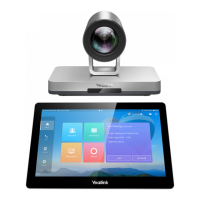Administrator’s Guide for Yealink VC800 Video Conferencing System
64
3. Enter the port of the STUN server in the Port field.
4. Select Save, and then press to accept the change.
To configure STUN server for SIP IP call via the remote control:
1. Select More->Setting->Advanced (default password: 0000) ->SIP IP Call.
2. Select STUN from the pull-down list of NAT Traversal.
3. Select Save, and then press to accept the change.
NAT Types
Full Cone:
A full cone NAT is one where all requests from the same internal IP address and port are
mapped to the same external IP address and port. Furthermore, any external host can send a
packet to the internal host, by sending a packet to the mapped external address.
Restricted Cone:
A restricted cone NAT is one where all requests from the same internal IP address and port are
mapped to the same external IP address and port. Unlike a full cone NAT, an external host (with
IP address X) can send a packet to the internal host only if the internal host had previously sent
a packet to IP address X.
Port Restricted Cone:
A port restricted cone NAT is like a restricted cone NAT, but the restriction includes port
numbers. Specifically, an external host can send a packet, with source IP address X and source
port P, to the internal host only if the internal host had previously sent a packet to IP address X
and port P.
Symmetric:
A symmetric NAT is one where all requests from the same internal IP address and port, to a
specific destination IP address and port, are mapped to the same external IP address and port. If
the same host sends a packet with the same source address and port, but to a different
destination, a different mapping is used. Furthermore, only the external host that receives a
packet can send a UDP packet back to the internal host.
Rport
Rport in RFC 3581, allows a client to request that the server sends the response back to the
source port from which the request came. Rport feature depends on support from a SIP server.

